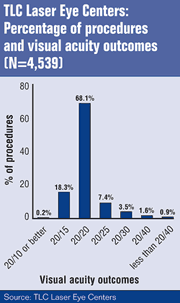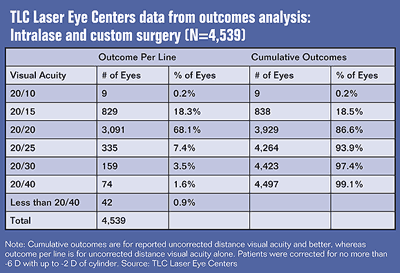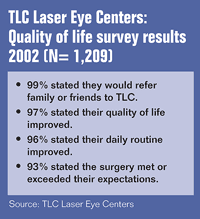Data indicate patient benefits to comanagement
 John W. Potter |
From time to time it is a good idea to review basic principles in eye and vision care, and comanagement is no exception.
Recently, during a public advisory committee meeting of the Food and Drug Administration Ophthalmic Devices Panel, presenters referred to the relationship between optometrists and refractive surgeons without referencing comanagement specifically, and we believe that was simply because it is universally thought of as an integral part of eye and vision care. In addition, the advisory committee also referred to the need for more studies and reports regarding outcomes of refractive surgery, particularly quality of life issues.
Is comanagement good for patients? We have a great deal of data on comanagement within TLC Laser Eye Centers. Last year more than 6,000 optometrists trusted TLC Laser Eye Centers and TLC medical directors with at least one of their patients. Of course, many doctors trusted TLC with more than one patient.
Benefits of comanagement
Let us consider how comanagement works and why it works well. It is important to take a step back and view comanagement from a broader perspective. The key to the comanagement relationship for the patient is straightforward.
 |
First, the patient can stay with his or her own doctor for most of the care. Second – and very importantly – the optometrist and the operating surgeon are both licensed independent professionals. The optometrist is not employed by the operating surgeon or the other way around. Each licensed independent professional is acting in his or her patients’ interests and each is compensated for the services he or she uniquely provides.
Within TLC Laser Eye Centers, no contract exists between these licensed independent professionals to refer patients one way or the other, and there are no authorities, other than the respective licensing boards, to dictate how each professional behaves. Optometrists and operating surgeons trust each other and support their mutual patients, and this is as it should be. If the optometrists or the operating surgeons did not trust each other as licensed independent professionals, then they should not, nor would they, work together. Our system works purely on the merits of each patient’s situation and the trust of the doctors in each other.
Outcomes data
Let us consider outcomes and quality of life. The accompanying large graph demonstrates outcomes analysis of all comanaged TLC patients’ eyes from July 1, 2007, through Dec. 31, 2007, for patients who were at least 90 days postoperative. The range of spherical equivalents is 0 to -6 D, and astigmatism is 0 to -2 D, which is most representative of our patients. All outcomes reported are for Intralase (Advanced Medical Optics, Santa Ana, Calif.) and custom surgery, which, again, is most representative of refractive surgery today in TLC Laser Eye Centers. To our knowledge, no such report of comanaged patients has ever been produced before publicly, or with such a large number of patients.
In the outcomes chart, we have taken the same data and presented it in more detail. Data from enhancements are not included.
Quality of life study
Our last study of quality of life following refractive surgery was reported in 2003. The TLC Quality of Life Survey was e-mailed to 4,659 patients who had refractive surgery in 2002, so we would have at least a 90-day postoperative period. The overall response rate was 26%, or 1,209 completed surveys.
 |
The results of the 1,209 survey responses are summarized in the quality of life chart. The results of these patients, for which the overwhelming majority were comanaged, are impressive, and we believe this demonstrates that comanagement brings value to quality of life after refractive surgery.
Independence, technology
This attitude of trust among licensed independent professionals expands throughout the organization. TLC Laser Eye Centers Clinical Services group performs a number of duties for the organization, the doctors and patients. Again, optometrists and ophthalmologists work together as independent, but trusting colleagues. This trust leads to an interdependence, which brings the best of both optometry and ophthalmology together.
The way we look at new technology is a function of both the ophthalmology and optometry perspectives. So, by the time a new technology is adapted, it reflects the views of the independent and interdependent optometrists and ophthalmologists and, as a result, the new technology is almost always successful for us.
Comanaged outcomes analysis
The outcomes analysis that the Clinical Services group produces is comanaged, as well. The results of this effort are multiple, but a few are particularly noteworthy.
 |
First, the outcomes analysis allows the operating surgeon to obtain a meaningful nomogram to help make the surgery for patients even better. It also allows us to compare technologies to see what works well and what can be improved. Finally, the outcomes analysis allows ophthalmologists and optometrists to use this information in informing their patients about the benefits of their surgery in quantitative means.
Our Clinical Services group really shines when it comes to clinical incidents or patients with complications.
We have seen that the unique perspective of optometrists and ophthalmologists working together from their independent positions and interdependent relationships benefits the patient. We have developed novel approaches to clinical issues that have proven successful, and we do not believe this could have occurred as readily outside a comanagement relationship. It is remarkable to see the vision perspective and the surgery perspective of optometrists and ophthalmologists respectively work toward the common goal of helping patients.
Overlying our Clinical Services group and the company itself is our Clinical Advisory Group. This group is composed of optometrists and ophthalmologists from nearly every facet of what TLC Laser Eye Centers does on a daily basis and in the course of patient care. Because the comanagement idea is so ingrained and at the bedrock of what has helped us be successful in refractive surgery, we have good discussions and meaningful decisions among licensed independent professionals.
For me, personally, it is the one environment where I can always be certain that cooperation and collaboration between optometry and ophthalmology will occur at a very high level. Good decisions for patients are made during these sessions, and this will continue as long as ophthalmologists and optometrists remain independent, yet interdependent.
Comanagement of conflicts
It is not unreasonable to consider the possibility of significant problems. Comanagement also exists at this level of patient care. We have a Patient Services group where disputes and conflicts are managed and resolved, if possible. Here, again, optometrists and ophthalmologists work together independently, but interdependently.
TLC has seen success in this area as well. I can count on one hand the number of ophthalmologists and optometrists together who have been anything less than cooperative and collaborative in helping patients and supporting each other. As a result, we rarely have litigation, and in nearly all cases we are able to resolve disputes and end conflict in a way that is better because of comanagement than without it.
This report of visual acuity outcomes for comanaged patients is a first step for us. We have more work to do and we will have more research to report in the future. Ultimately, we believe comanagement between licensed independent professionals in optometry and ophthalmology has been beneficial for patients, for the professionals themselves and for refractive surgery.
For more information:
- John W. Potter, OD, FAAO, is vice president for patient services for TLC Laser Eye Centers, Dallas, and a member of the Primary Care Optometry News Editorial Board. He can be reached at TLC Laser Eye Centers, 18352 Dallas Parkway, Suite 136, Dallas, TX 75287; (972) 818-1239; fax: (972) 818-1240; e-mail: john.potter@tlcvision.com.
- Christopher J. Quinn, OD, FAAO, a Primary Care Optometry News Editorial Board member and president of Omni Eye Services, can be reached at Omni Eye Services, 485 Route 1, Ste. A, Iselin, NJ 08830-3009; (732) 750-0400; fax: (732) 750-1507; e-mail: quinn@omnieyeservices.com.
References:
- Public advisory committee meeting of the Food and Drug Administration Ophthalmic Devices Panel. To access the report, log on to www.gpoaccess.gov/fr/index.html and search for “LASIK.” Click on the first link, either in HTML, PDF or summary format.
- TLC Quality of Life Survey, TLC Vision Corporation, 2003.
